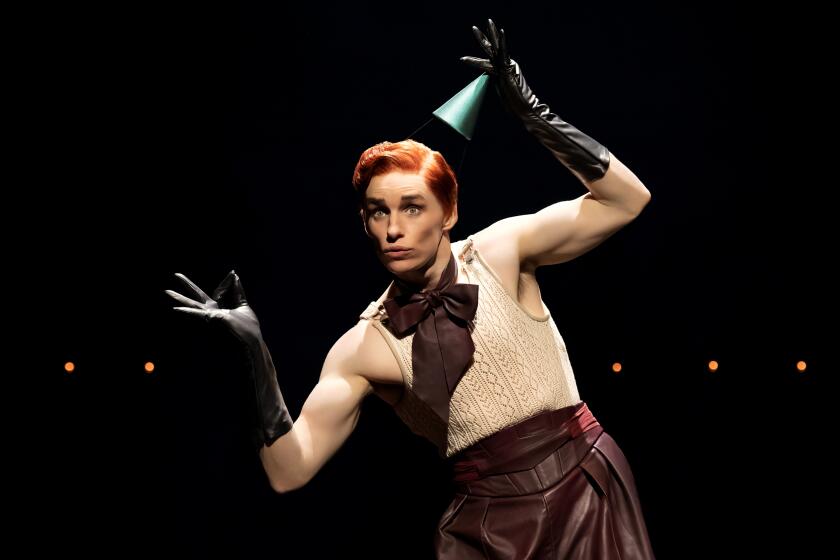Prized 18th century screens join LACMA’s Japanese art collection
Seventeen years have passed since Robert T. Singer, curator of Japanese art at the Los Angeles County Museum of Art, spotted an extraordinary pair of 18th century screens in an exhibition at the Kyoto University Museum of Art.
Smitten with Maruyama Okyo’s exquisitely detailed depiction of 17 life-size cranes on a glowing background of gold leaf, he decided that LACMA had to have the rare and valuable artwork.
It took 13 years, amid many other projects, for Singer to find the owner of the privately held screens. An additional four years went by while he negotiated the deal, secured an export license, transported the 5 1/2-foot-tall, 22-foot-long work to Los Angeles and installed it in its new home.
But “Cranes” will finally go on view Saturday at the museum’s Pavilion for Japanese Art. The birds, which symbolize good fortune and long life in Japanese culture, have landed. And, after all these years, Singer is bursting with pride.
PHOTOS: Arts and culture in pictures by The Times
“This is the finest pair of Japanese screens to leave Japan in its 440-year history of Western contact,” Singer says.
The only other Okyo works in the same league, he says, are four sets of screens that have been designated National Treasures by the Japanese government and restricted from leaving the country, except as loans.
LACMA’s acquisition was funded by Camilla Chandler Frost, a long-time trustee of the museum and the sister of Otis Chandler, former publisher of the Los Angeles Times. She made the gift in honor of Singer.
The museum has not disclosed the purchase price, but its version of “Cranes” appears to be superior in condition and aesthetic quality to a pair of Okyo crane screens that brought $1.1 million from an unidentified buyer in 2007 at Christie’s New York auction house.
Laura Allen, curator of Japanese art at the Asian Art Museum in San Francisco, has not seen “Cranes,” but she ranks Okyo, who lived from 1733 to 1795, as “one of the most significant Japanese artists of the 18th century.”
In an email exchange, Allen wrote that the artist, who founded the Maruyama-Shijo school of painting in Kyoto, “is known for a naturalistic style, evident in the meticulously observed forms and varied poses of the cranes in LACMA’s new screens.”
Singer calls Okyo “a great revolutionary” whose practice of painting directly from nature was a new idea in his time. In “Cranes,” the curator says, Okyo introduced “a new level of abstraction by removing everything but the birds. And yet, his work is not obscure, not difficult to understand. It’s appealing to everyone.”
The artwork portrays 12 red-crowned cranes, a particularly auspicious symbol of good luck at New Year’s time, and five white-naped cranes. The birds stand on long, spindly legs or tuck them under fluffy bodies. Their necks swoop in graceful curves or twist into pretzel-like loops. Arranged so that each panel or group of panels is a striking composition, the sharp-eyed cranes stroll about, as if observing their surroundings, cluster in groups or withdraw in a private space.
Painted in 1772, when the artist was in his late 30s, “Cranes” is a prime example of Okyo’s relatively early, intricately patterned work. In the artist’s later years, as his vision faded, he developed a looser style and enlisted the help of his students, Singer says.
LACMA’s screens have been widely published, but rarely shown. Sequestered in two Japanese family collections for most of their lives, the artwork was in the Yamada collection in Kyoto until 1926, and in the Harahan collection in Kobe thereafter. The 1996 exhibition in Kyoto was the first public display of “Cranes,” Singer says. It was also shown in 2004 at a major exhibition at the Osaka Museum of Art.
Okyo’s work is widely collected in Japan and the United States. The Metropolitan Museum of Art in New York, the Museum of Fine Arts in Boston and the Smithsonian Institution’s Arthur M. Sackler Gallery in Washington all have multiple examples of his art, including screens, scrolls, paintings and drawings, but nothing like LACMA’s “Cranes.”
San Francisco’s Asian Art Museum will show a pair of screens by Okyo in its Japanese galleries beginning April 1, Allen says. And four major works by the artist will be featured in the museum’s summer 2013 exhibition, “In the Moment: Japanese Art from the Larry Ellison Collection.”
At LACMA, “Cranes” has joined a collection of about 6,500 works of Japanese art, including two Okyo screens, “Landscape in Snow” and “Puppies among Bamboo in Snow,” both painted in 1784. The new acquisition is installed in a gallery that will allow viewers to compare it to the artist’s later work.
But most important, Singer says, is that, in “Cranes,” visitors to LACMA will have an opportunity to see a major achievement in the history of Japanese art.
ALSO:
Cirque du Soleil laying off 400 workers
Pacific Standard Times turns its focus to architecture
Russia held in contempt in case that sparked loan-ban
MORE
INTERACTIVE: Christopher Hawthorne’s On the Boulevards
VOTE: What’s the best version of ‘O Holy Night’?
PHOTOS: Arts and culture in pictures
More to Read
The biggest entertainment stories
Get our big stories about Hollywood, film, television, music, arts, culture and more right in your inbox as soon as they publish.
You may occasionally receive promotional content from the Los Angeles Times.






